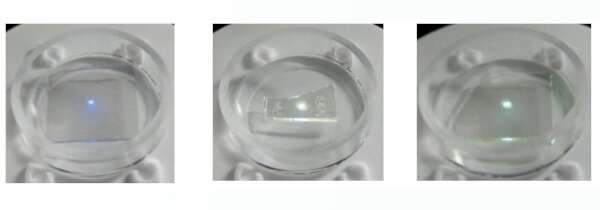GaN crystals under photo-excitation. Carbon concentration level from left to right: high, medium, and low. Credit: Kazunobu Kojima
Carbon impurity has long hindered efficiency in nitride-based electronic and optical devices. But Researchers at Tohoku University, have discovered a method that can quickly detect carbon impurity using light.
The use of blue and white light-emitting diodes (LEDs) that use nitride semiconductors- specifically indium gallium nitride (InGaN) and gallium nitride (GaN) - has led to a steep increase in energy efficiency. Naturally, researchers have tried to replicate this in optical and electronic applications by using nitride semiconductors. However, a common issue arises due to carbon impurity, which significantly degrades performance.
Carbon impurity leads to deep-traps, an undesirable electronic defect by which performance is substantially reduced. However, detecting carbon impurity in semiconductor crystals is a time-consuming and costly process. Some methods necessitate creating additional electrodes onto the crystal. Thus, raising costs and inhibiting the inspection speed. Other methods result in the breakage of nitride crystals; therefore, rendering the crystals useless.
Nevertheless, Associate Professor for the Institute of Multidisciplinary Research for Advanced Materials at Tohoku University, Kazunobu Kojima and his team solved this problem by creating a way to identify carbon impurity using a probing technique utilizing light that makes no physical contact with the crystals. The technique is named omnidirectional photoluminescence (ODPL) spectroscopy.
The process of ODPL firstly involves illuminating a crystal, such as GaN, via external light. The external light is absorbed by the crystal, thereby stimulating it. In order to return to its initial state, therefore, the crystal creates a light to dissipate excess energy.
Utilizing the ODPL allows for the quick evaluation of photoluminescence efficiency with high accuracy. Since carbon impurity reduces the photoluminescence efficiency, researchers can also determine the carbon concentration by assessing the PL efficiency.
Professor Kojima explained the benefits of such a system. "Optical probing technologies are immensely beneficial due to their nondestructive nature. By using light, we can therefore, help detect carbon impurity which is ultimately such a hindrance for GaN devices, such as LEDs and power transistors."
An added benefit of the ODPL spectroscopy is that is not only limited to nitride-semiconductor-based application. It can check any light-emitting materials that contain optical and electronic properties. An example would be perovskites, which is currently used in the manufacturing of high-efficiency solar cells.
More information: Kazunobu Kojima et al. Roles of carbon impurities and intrinsic nonradiative recombination centers on the carrier recombination processes of GaN crystals, Applied Physics Express (2019). DOI: 10.7567/1882-0786/ab5adc
Provided by Tohoku University























